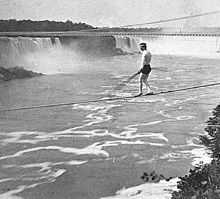Stephen Peer

Stephen Peer (1840-1887) was a tightrope walker who, though he completed the feat successfully many times, fell to his death while walking a tightrope over Niagara Falls.
Biography
Peer had decided to become a tight rope walker when he was 19 years old, inspired by Blondin who had performed the trick over Niagara Falls. Peer had been born and raised in the Stamford Township and wanted to be the first local resident to successfully cross the falls on a tight rope. Peer became an assistant to Henry Bellini in 1873, but that ended when Peer attempted to use Bellini's equipment without his permission. Bellini reportedly tried to cut down a tight rope while Peer was standing on it, but the townsfolk ran Bellini out of town. On June 22, 1887 Peer completed a tight rope walk over the Niagara from the present Whirlpool Bridge and Penn Central Bridge, and back again. Three days later on June 25, 1887 Peer was reportedly with some friends, and had been drinking, and he fell off a tightrope to his death.
References
External links
Article from the Action Free Press newspaper 12 June 1879, page 4
Leaping into Niagara The Daring and Unprecedented Exploit of an Adventurous Canadian (From the Buffalo Post)
During the past two or three weeks it has been announced from gay-coloured bills conspicuously posted throughout the country between Buffalo, Niagara Falls, and the city of Elmira, that H.P. Peer, the champion perpendicular jumper would perform the reckless feat of jumping from the new suspension bridge at the Falls into the water below, a distance of 188 feet. This was something wholly without precedent. Only one other man had ever dared to leap from this lofty structure, and he did it with suicidal intent, sadly successfully accomplished his purpose.
Out on the bridge, about 25 feet beyond the neutral line, and toward the American side, a temporary platform had been erected outside the guard rail on a level with the floor of the bridge. It consisted simply of two narrow planks extending out about 4 feet and about eighteen inches apart, with a piece of board nailed over the ends. Above this extending out from the upper edge of the guard-rail was a cylinder or a windless[sic] on which was reeled a small 6 strand cable composed of 220 feet of No. 24 brass wire. The revolutions of the cylinder were controlled by a small wooden brake handle.
At the appointed time Peer took his place on the bridge behind the guard-rail and behind his platform to receive the finishing touches from his attendants. He was attired in __(?)__ hose and a suit of tights with blue trunks. Fitting tightly about his hips and close to his body and passing up just under his arm pits was a funnel-shaped inflated rubber life preserver constructed after an arrangement perfected and known holy to himself. Strips of cotton were tightly banded around his hips and loins. A broad sponge covered his mouth and nostrils and his ears were filled with the same material, the sponge first being moistened with spirits. Over the shoulders was a leather sling or brace which passed behind in the form of a loop and having a small brass ring in the centre. When all was in readiness the signal was given to the boatman in the river below to get ready, and then Peer, after taking some stimulant, gave a final look to his dress to see that everything was alright, adjusted his sponge protectors and crept over the rail upon his scaffold where he sat for a brief time and surveyed the distance he was soon to travel. The object of the windlass and cable was now learned, the cable being attached to the ring in the sling he wore and intended to prevent his turning over to make sure his maintaining a perpendicular position, while the use of the brake upon the cylinder would enable those above in a measure to control his decent. The final end of the cable fastened so that as he descended it would rewind and not hold him. When the wire had been attached he stood up cross-legged and fastened his limbs in this position with a stiff elastic band about 2 inches wide slipped over his thighs and another over his feet at the in-step. This was a precautionary measure to guard against his legs spreading.
Peer lowered himself between the two boards of his scaffolding and hung first by two hands and then by one. After a moment's delay Peer again took hold with both hands, straightened himself out and with a "Good by" at twenty minutes before four o'clock let go, let his hands drop close to his side and went down like an arrow. Peer shot directly and with almost lightning velocity and looking like a small boy to those above, disappeared with a great splash, feet foremost, sending the water three or four feet into the air. He came out about fifty feet below the place where he entered and started to swim, went down a short distance below the bridge and was picked up by Thomas Conroy, the guide, and two other men who were in the boat. He seemed a little limp, but this, it was said was due to his being struck on the shoulder by the boat. His life preserver burst when he struck the water.
Peer was born in 1844 near Hamilton Canada and has made some astonishing leaps before.
submitted by Patricia Jackson, Milton Ontario Canada